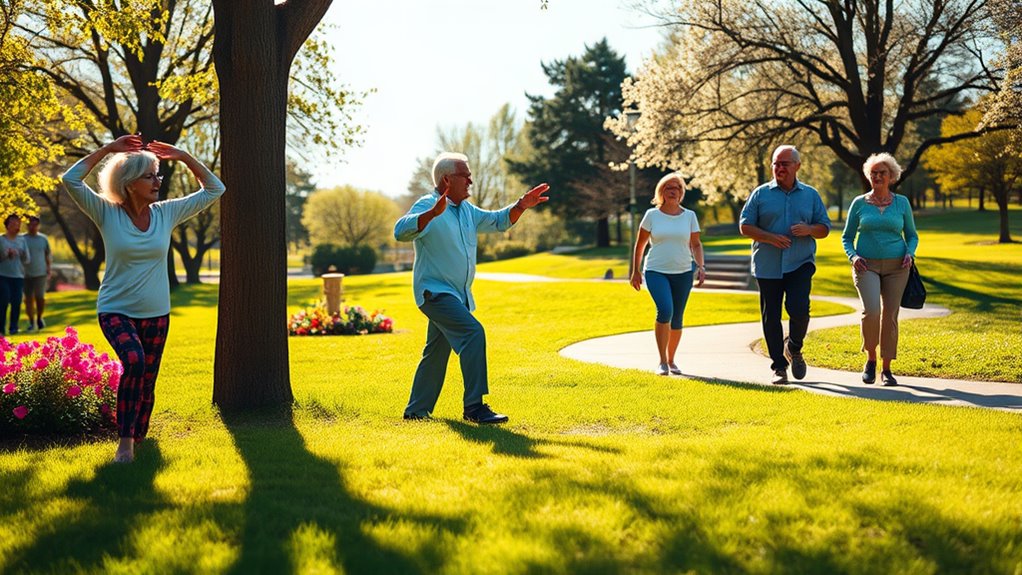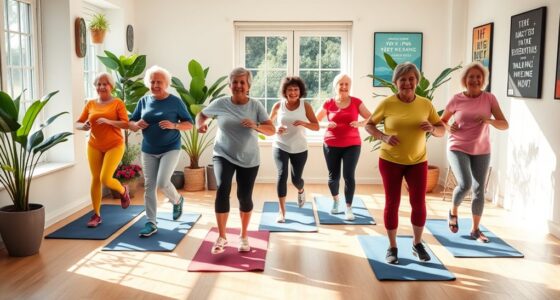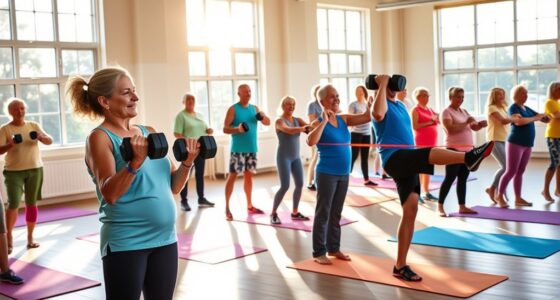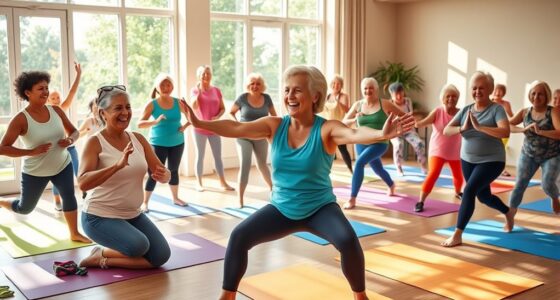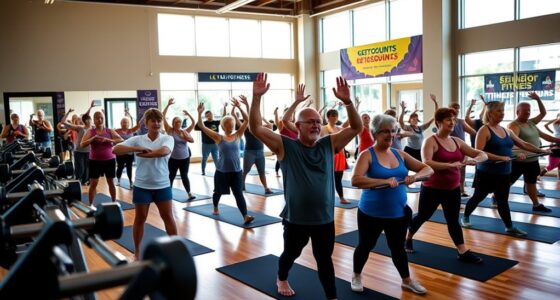Exercise routines for seniors boost your energy and overall health notably. Aim for 150 minutes of moderate aerobic activity weekly, broken into short sessions. Include strength training twice a week to maintain muscle mass and bone density. Incorporate low-impact activities like walking or water aerobics, and practice balance exercises three times a week to reduce falls. Don’t forget stretching to enhance flexibility. Keep going to discover more tips for staying active and vibrant as you age!
Key Takeaways
- Aim for at least 150 minutes of moderate-intensity aerobic activity weekly, broken into 10-15 minute sessions for manageable daily energy boosts.
- Include strength training exercises twice a week, focusing on major muscle groups to maintain muscle mass and enhance functional abilities.
- Incorporate balance exercises three times weekly, such as tai chi or single-leg stands, to reduce fall risk and improve stability.
- Engage in low-impact activities like walking or water aerobics to promote cardiovascular health while minimizing joint stress and enhancing mobility.
- Join community fitness programs for motivation and social interaction, making exercise enjoyable and fostering a supportive environment.
Health Benefits of Exercise for Seniors

When you engage in regular exercise, you’re not just staying fit; you’re also enhancing your overall quality of life.
For seniors, the health benefits of exercise are immense. Regular physical activity can markedly reduce the risk of chronic diseases like heart disease and diabetes by up to 30%. It also boosts your mood and cognitive function, helping alleviate symptoms of depression and anxiety. Engaging in regular exercise fosters a growth mindset that encourages you to push beyond your limits and embrace new challenges. Additionally, incorporating essential oils can enhance relaxation and recovery after exercise, further supporting your well-being. Regular physical activity can also significantly improve medication management for seniors, ensuring optimal health outcomes. Furthermore, participating in activities that include pet therapy can enhance emotional well-being and social interaction.
Regular exercise significantly lowers the risk of chronic diseases and enhances mood and cognitive function for seniors.
Incorporating balance exercises into your routine can decrease the likelihood of falls by 23%, promoting greater confidence in your physical abilities. An active lifestyle also increases your energy levels and improves sleep quality by reducing stress. Additionally, maintaining an emergency fund can provide financial security, allowing you to focus more on your health and well-being.
Embracing these benefits empowers you to maintain independence and liveliness in your daily activities.
Recommended Exercise Frequency
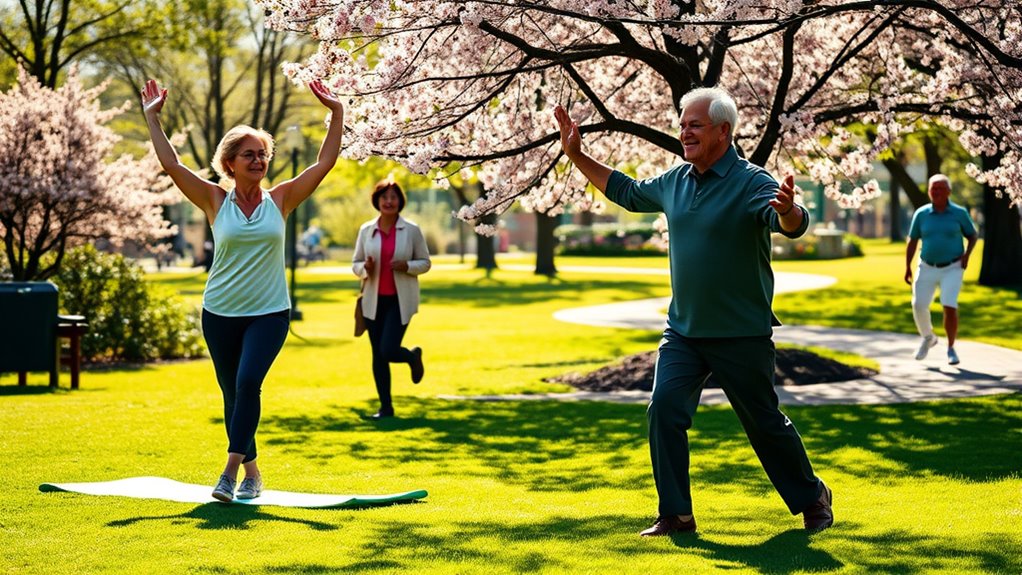
To maintain ideal health, seniors should aim for at least 150 minutes of moderate-intensity aerobic activity each week. You can break this down into manageable sessions of 10 to 15 minutes. Alternatively, 75 minutes of vigorous-intensity activity weekly is also recommended. It’s essential to include at least two days of muscle-strengthening activities to support overall fitness and bone health. Additionally, incorporate balance activities into your routine three times a week to reduce the risk of falls and enhance stability. Engaging in mindfulness and relaxation techniques can also help improve overall well-being during exercise, as this aligns with the importance of relaxation before sleep for better manifestations. Furthermore, self-care routines are vital for replenishing energy levels and promoting overall health in seniors. It’s important to understand that maintaining an active lifestyle can also lead to long-term energy savings by reducing the need for excessive medical interventions. Furthermore, good grief and emotional support can play a significant role in overall health and energy levels during this phase of life.
Strength Training for Seniors
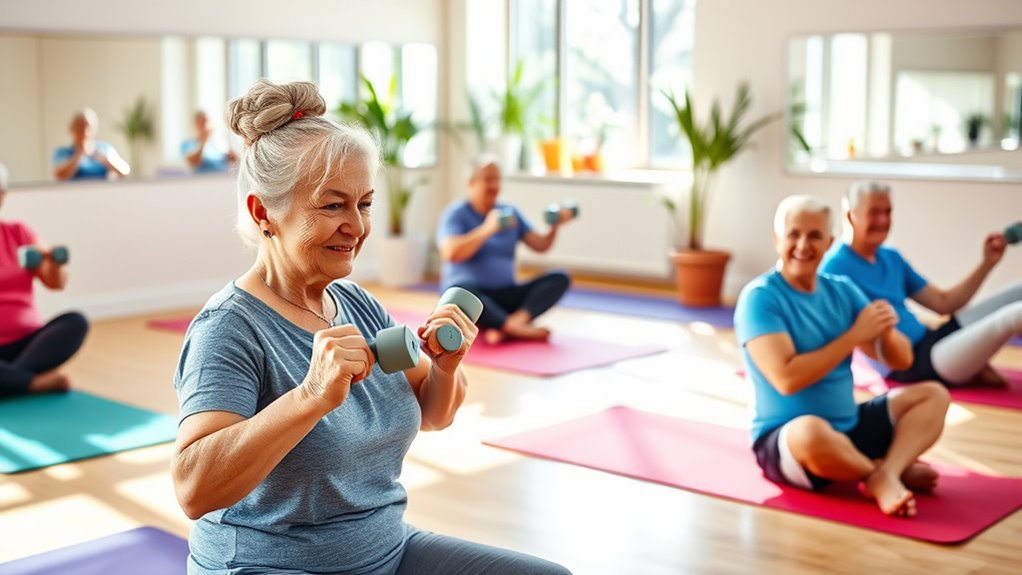
Strength training is essential for you as a senior, helping to maintain muscle mass and bone density while reducing the risk of injuries. By engaging in simple exercises like wall push-ups and pelvic tilts at least twice a week, you can enhance your mobility and balance. Additionally, incorporating holistic care models into your routine can support overall health and well-being. Recent studies show that regular strength training exercises can significantly improve your functional abilities and independence. Engaging in strength training not only improves physical health but also boosts mental wellbeing, which is crucial for maintaining a positive outlook on life. Moreover, participating in activities like watering techniques for your indoor plants can provide a calming, meditative experience that contributes to your mental health. Regular strength training can also enhance your overall emotional health, fostering resilience and a sense of accomplishment. Let’s explore the benefits of strength training and some recommended exercises to get you started.
Benefits of Strength Training
Empowerment through strength training brings numerous benefits for seniors, enhancing both physical and mental well-being. Regular strength training helps you maintain muscle mass and bone density, essential for combating age-related changes. Engaging in these activities at least twice a week can improve your balance and coordination, greatly reducing the risk of falls. Additionally, audits in SQA processes can enhance your overall routine by ensuring that your exercise plans are effective and tailored to your needs. Plus, it boosts self-esteem and alleviates symptoms of anxiety and depression. Additionally, studies show that regular exercise, including strength training for seniors, can lead to improved overall health outcomes. Incorporating strong communication skills into group exercise sessions can further enhance social interaction and motivation among participants. Moreover, NLP in customer experience can also be applied to fitness programs, making them more personalized and engaging for seniors. It’s also important to consider estate planning as part of a holistic approach to health, ensuring your loved ones are taken care of as you focus on your well-being.
| Benefits of Strength Training | Description |
|---|---|
| Maintain Muscle Mass | Prevents age-related muscle loss |
| Improve Balance | Reduces the risk of falls |
| Enhance Functional Performance | Aids in daily tasks |
| Boosts Mental Well-Being | Improves self-esteem |
| Supports Bone Health | Combats osteoporosis |
Recommended Strength Exercises
Engaging in just a few key strength exercises can make a significant difference in your overall health as a senior. Incorporating strength training into your fitness routine helps maintain muscle strength and bone density, essential for staying healthy and preventing osteoporosis. Additionally, omega-3 fatty acids have been shown to support cognitive function, which can further enhance your physical activities. Including a variety of fruits, such as apples and pears, in your diet can also provide essential nutrients that support overall health. Moreover, juice cleansing can serve as an effective method for detoxification, complementing your healthy lifestyle.
Aim for at least two days a week of muscle-strengthening activities, focusing on major muscle groups like your back, abdomen, and legs. Simple exercises such as wall push-ups, pelvic tilts, and abdominal contractions can easily be performed at home with minimal equipment. Creating a calm environment through decluttering can also enhance your focus and motivation when engaging in these exercises.
These activities enhance your balance and mobility, promoting independence in daily tasks. Additionally, self-directed IRAs can provide financial freedom that encourages a more active and fulfilling lifestyle in your retirement years. Remember to consult with your healthcare provider before starting any new exercise for seniors to guarantee it suits your individual health needs and abilities.
Low-Impact Activities
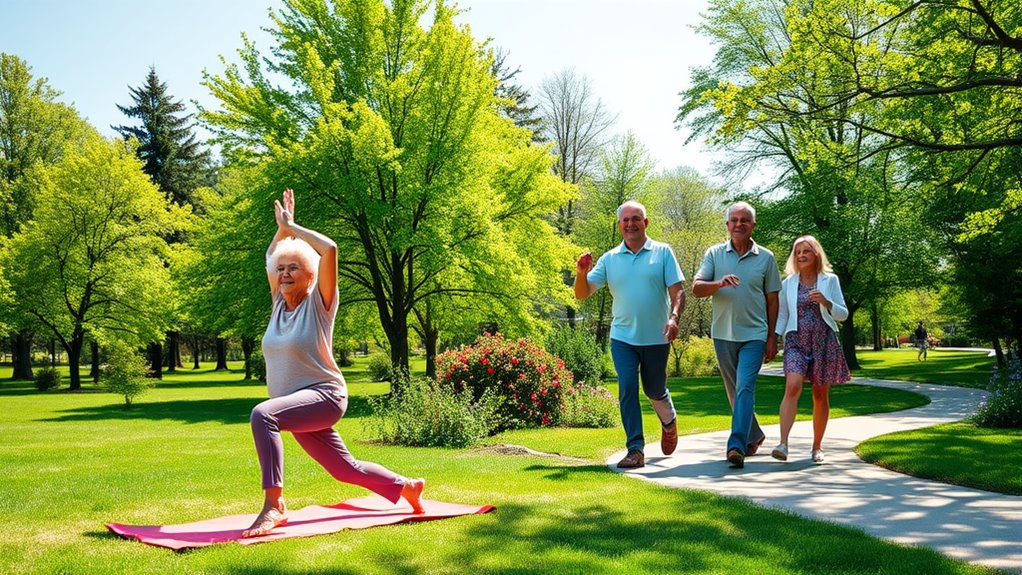
When it comes to staying active, low-impact activities like swimming, cycling, and yoga are perfect for seniors who want to reduce their risk of injury while still reaping the benefits of cardiovascular exercise. These exercises support your body weight, build strength, and improve flexibility, making them ideal if you have joint pain or limited mobility. Regular participation in low-impact activities can greatly enhance your cardiovascular health and overall well-being.
| Activity | Benefits |
|---|---|
| Swimming | Low impact, builds endurance |
| Cycling | Strengthens legs, boosts mood |
| Yoga | Increases flexibility, reduces stress |
Incorporating these activities into your routine can help you achieve the recommended 150 minutes of moderate aerobic activity, promoting independence and quality of life.
Cardiovascular Exercises

Low-impact activities set a solid foundation for cardiovascular exercises, which are essential for maintaining heart health as you age. Aim for at least 150 minutes of moderate-intensity activity weekly to boost your energy levels and overall endurance.
Here are three effective low-impact options to contemplate:
- Walking: Short, regular walks of 10 to 15 minutes can help you reach your fitness goals without overwhelming you.
- Water Aerobics: This fun, social activity reduces joint pain while providing a great workout for your heart.
- Cycling: Whether on a stationary bike or outdoors, cycling is another excellent way to improve your cardiovascular fitness safely.
Incorporate these exercises into your routine for better sleep quality and to combat symptoms of chronic diseases.
Balance Exercises

Balance exercises are essential for seniors, as they greatly lower the risk of falls, a concern for one in four older Americans each year. Incorporating regular exercise into your routine can markedly improve balance and enhance your overall stability.
Simple activities like single-leg stands, where you lift one foot off the ground for 10-30 seconds, can easily fit into your daily life—even while waiting in line. Tai chi and weight shifting exercises are also excellent options to practice at least three times a week.
Flexibility and Stretching Exercises
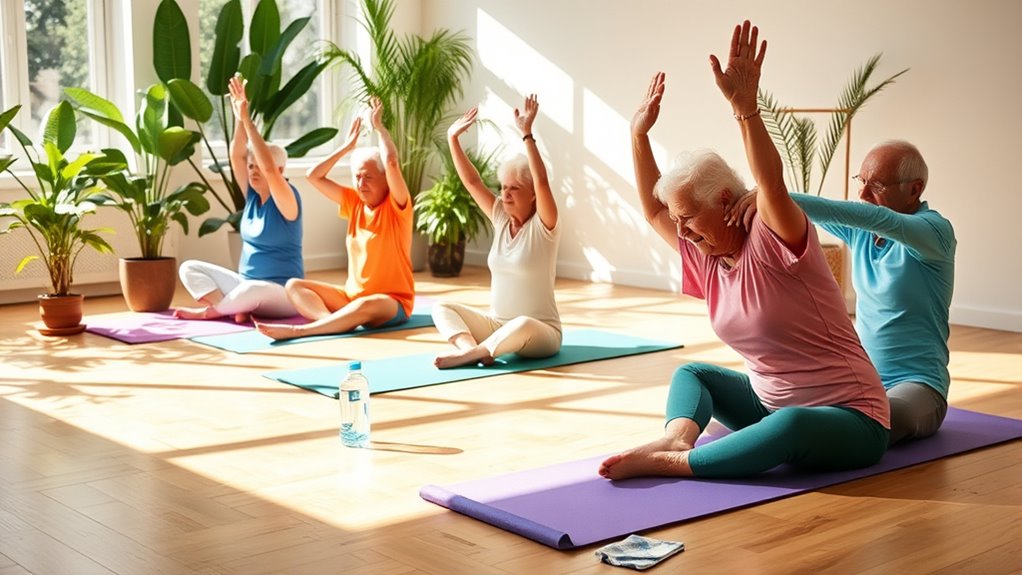
Improving your balance through targeted exercises is just one part of maintaining overall physical health as you age.
Flexibility is equally important, and incorporating daily stretching exercises can enhance your range of motion and comfort in everyday activities.
Here are three effective stretches to include in your routine:
- Neck Stretches: Slowly turn your head from side to side, holding each position for 10-30 seconds to relieve tension and promote flexibility.
- Shoulder Rolls: Perform controlled backward and forward rotations of your shoulders to enhance mobility and reduce stiffness.
- Ankle Circles: Lift one foot slightly and rotate your ankle in circular motions to improve flexibility and strength, which is essential for maintaining balance.
Integrating these gentle stretches can support your agility and help prevent falls.
Five Favorite Exercise Videos
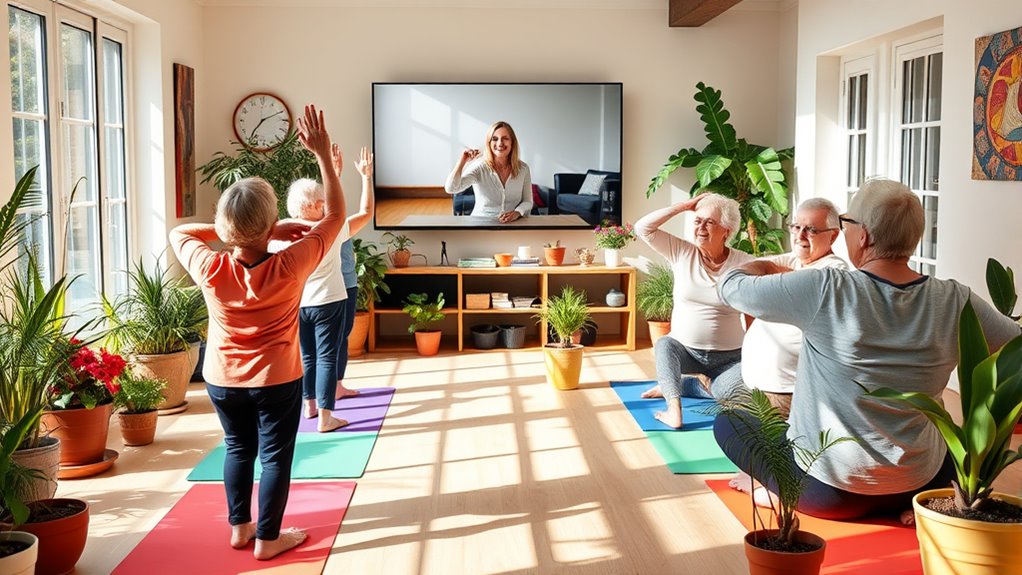
Finding the right exercise routine can make a significant difference in your overall health, especially as a senior. Here are five favorite exercise videos that cater to your needs, focusing on strength, mobility, and low-impact cardio:
| Video Title | Focus Area |
|---|---|
| 5-Minute Low-Impact Cardio with Belinda | Quick cardio for beginners |
| 10-Minute Sit & Stand for Strength with Cedric | Building strength and stability |
| 15-Minute Mobility with Belinda | Enhancing flexibility and movement |
| Accessible for busy schedules | Easy to incorporate daily |
| Available for free on the PF App | Convenient resource for seniors |
These fitness classes guarantee you can stay active without straining your joints, all while fitting seamlessly into your daily routine.
Community Support and Accessibility of Workouts
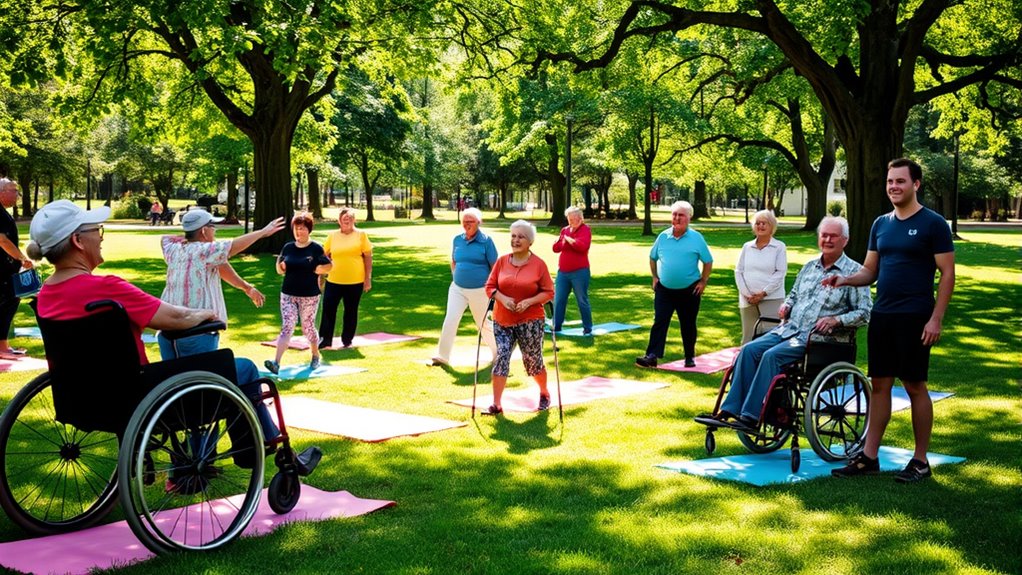
Joining a group workout can really boost your motivation and make exercising more enjoyable.
With trainers available to guide you, you’ll feel more confident taking on new routines.
Plus, flexible scheduling options mean you can easily fit workouts into your day, making it easier to stay active.
Group Workout Benefits
While many seniors may feel hesitant to start a fitness routine, group workouts offer a supportive environment that can make all the difference.
Engaging in these classes not only provides social interaction but also fosters community support, making exercise more enjoyable and motivating.
Here are three key benefits of group workouts:
- Enhanced Motivation: Exercising with peers encourages you to stick to your fitness routines.
- Accountability: Being part of a group creates a sense of belonging, helping you remain consistent.
- Affordability: Many senior programs, like SilverSneakers, offer affordable classes, making it easier for you to access great workouts.
With trained instructors to guide you on proper form, group workouts keep your fitness journey both safe and engaging.
Trainer Guidance Availability
Accessing trained trainers can markedly enhance your exercise experience, especially for seniors looking to stay active. With robust trainer guidance availability, you can receive personalized training sessions tailored to your unique fitness goals and physical abilities.
Many fitness centers and senior living communities offer specialized classes led by instructors who understand the specific needs of older adults. This community support for seniors fosters a safe and effective environment for your workouts.
Additionally, online platforms like the PF App provide access to guided workout videos and live classes, making it easy to maintain your exercise regimen from home. Engaging in these activities not only boosts your current fitness but also encourages social connections, keeping you motivated and involved.
Flexible Scheduling Options
When you consider incorporating exercise into your routine, flexible scheduling options play an essential role in making it manageable and enjoyable. These options help you reach the recommended 150 minutes of moderate-intensity activity each week.
Here are three ways to embrace these options:
- Community Support: Join group workouts or fitness classes, fostering social connections that boost motivation.
- Access to Trainers: Utilize community resources for guidance and encouragement, ensuring you progress safely in your exercise routines.
- Online Platforms: Explore various workout videos and routines that cater to your fitness level, allowing for at-home workouts when it suits you.
Frequently Asked Questions
What Is the Daily Exercise Routine for the Elderly?
To create a daily exercise routine for the elderly, aim for at least 30 minutes of moderate activity, like brisk walking or cycling. You can break it into shorter sessions if needed.
Incorporate strength training twice a week with exercises like wall push-ups and seated leg lifts. Include balance exercises three times weekly, plus daily stretching to improve flexibility.
Consider low-impact activities like swimming to keep your joints healthy while getting a full-body workout.
What Is the Number 1 Exercise to Increase Balance in Seniors?
Think of your balance like a tightrope walker—steady and focused.
The number one exercise to increase balance in seniors is the single-leg balance. You lift one foot off the ground and hold the position for 10-30 seconds, switching sides.
Practicing this at least three times a week can greatly reduce your fall risk. It’s simple and can be done anywhere, helping boost your confidence and coordination while enhancing your overall stability.
What Is the Number One Exercise for Seniors?
The number one exercise for seniors is walking. It’s a low-impact activity that you can easily fit into your daily routine.
Walking improves your cardiovascular health and boosts your mood. Aim for at least 150 minutes of moderate-intensity walking each week, and you’ll notice increased energy levels and better balance.
Plus, walking in groups can enhance your social interactions, which is great for your mental well-being.
How to Create a Workout Plan for Seniors?
To create a workout plan for seniors, start by evaluating your current fitness level and any limitations.
Set specific, achievable goals like 150 minutes of moderate aerobic activity each week, plus two days of strength training.
Mix activities to keep things interesting, like walking or swimming.
Schedule workouts at convenient times, and don’t forget to include warm-ups and cool-downs to help your body prepare for and recover from exercise.
Conclusion
Incorporating exercise into your daily routine can be as invigorating as a cool breeze on a hot day. By prioritizing your health with a mix of strength training, low-impact activities, and balance exercises, you’ll not only boost your energy but also enhance your overall well-being. Remember, staying active doesn’t have to be overwhelming—start small, stay consistent, and lean on community support. Embrace this journey, and you’ll feel more vibrant and alive every day!
